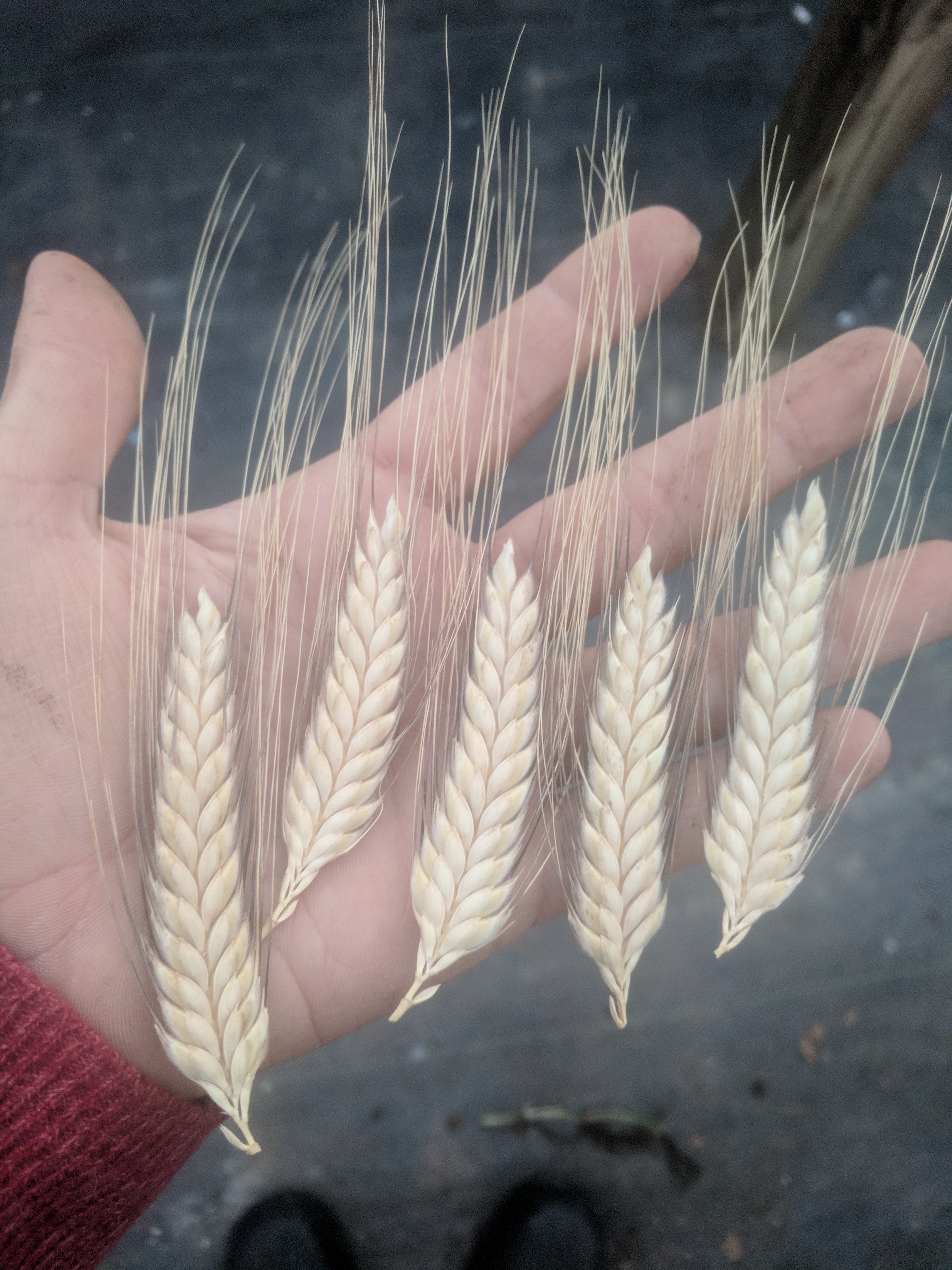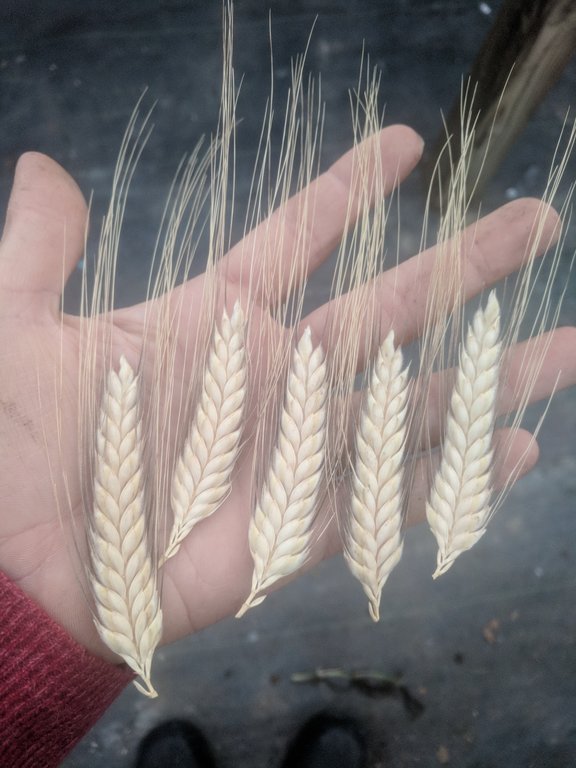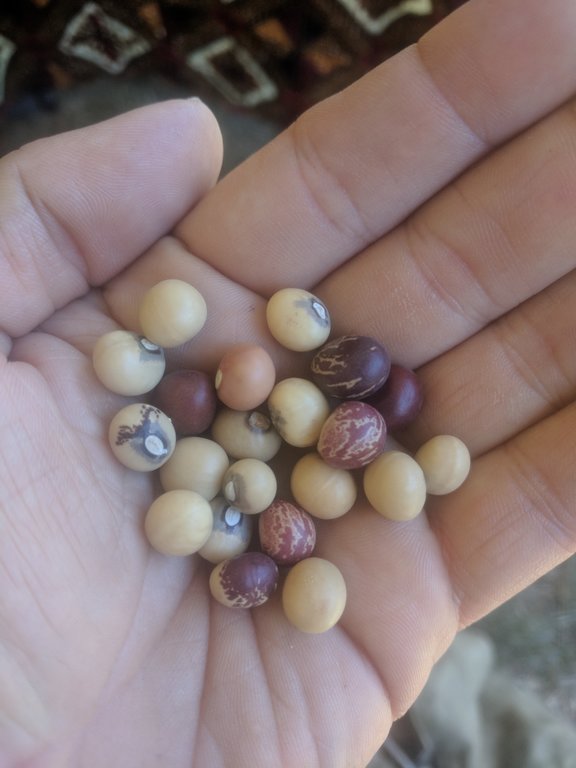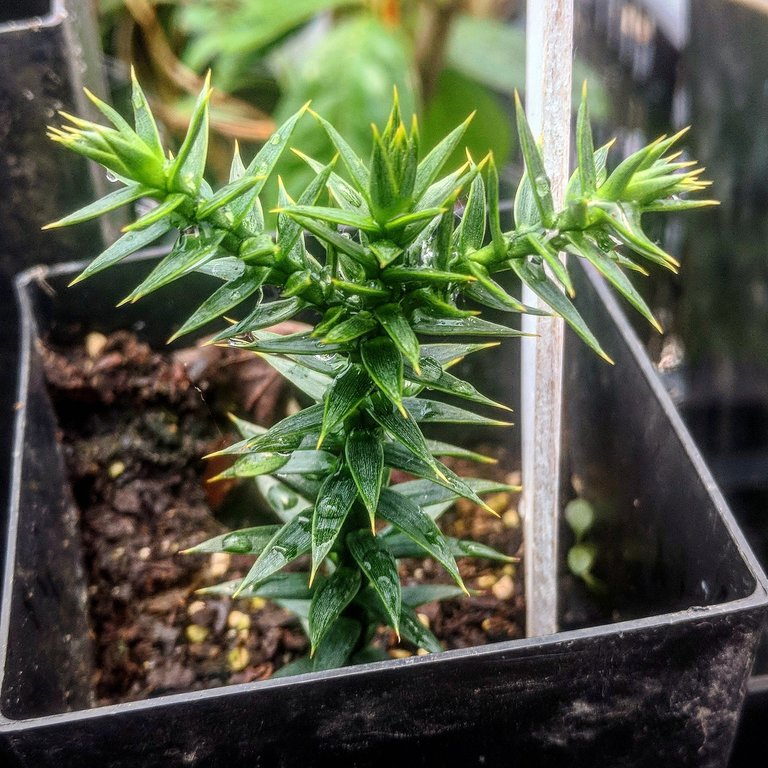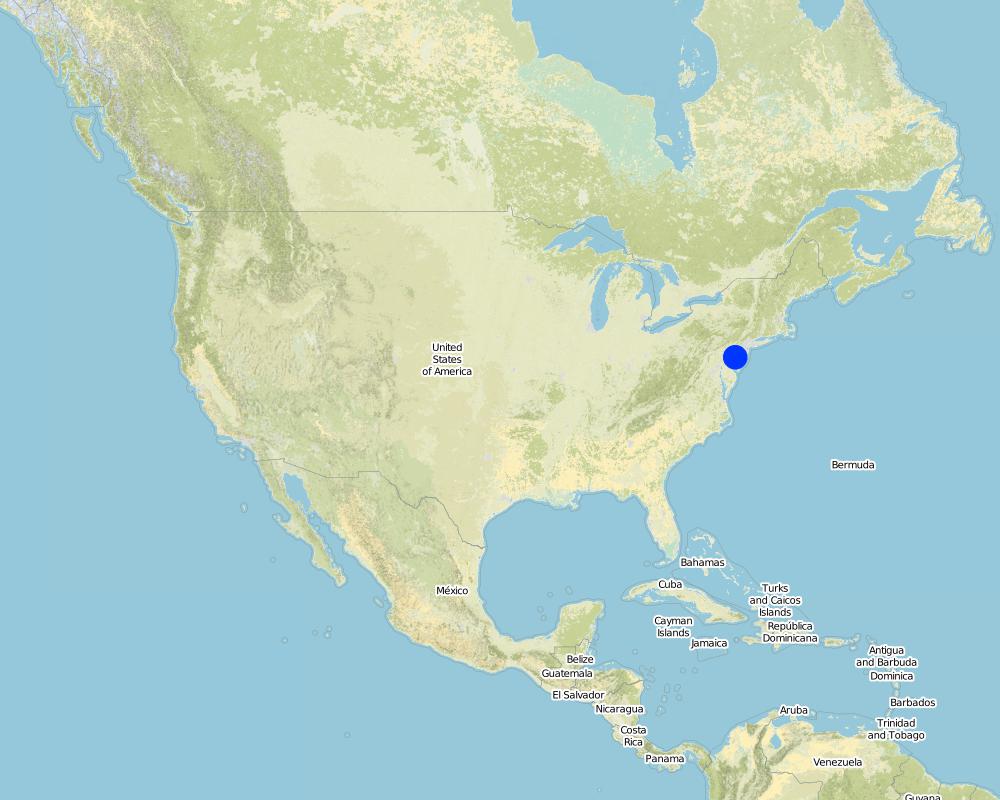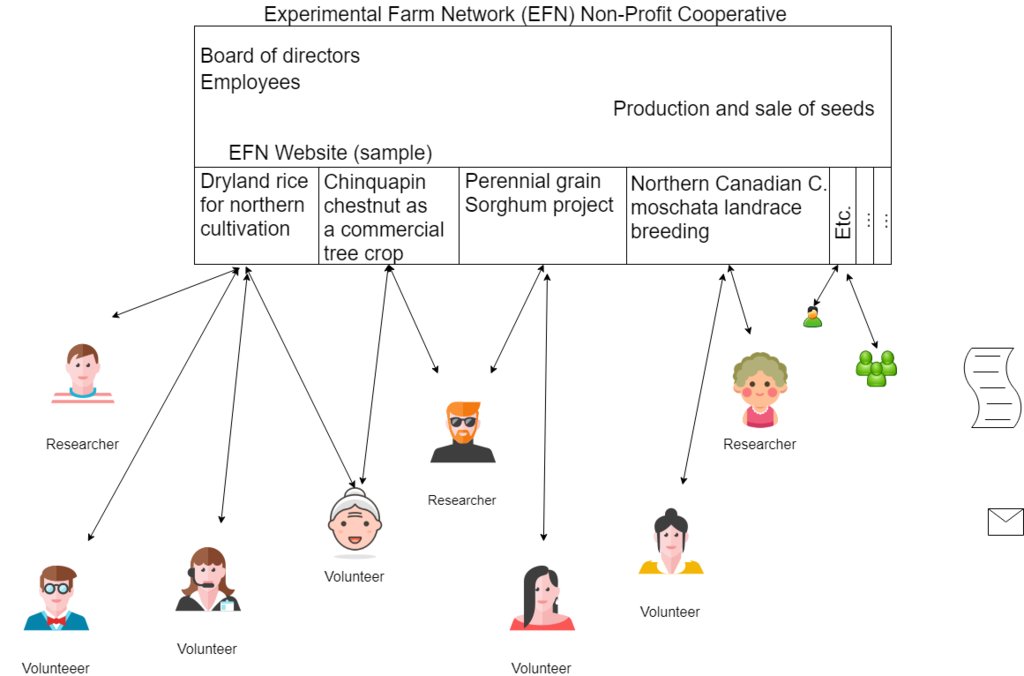Experimental Farm Network for collaborative plant breeding and sustainable agriculture research. [สหรัฐอเมริกา]
- ผู้สร้างสรรค์:
- การอัพเดท:
- ผู้รวบรวม: Stefan Graf
- ผู้เรียบเรียง: –
- ผู้ตรวจสอบ: Alexandra Gavilano
approaches_4199 - สหรัฐอเมริกา
ดูส่วนย่อย
ขยายทั้งหมด ย่อทั้งหมด1. ข้อมูลทั่วไป
1.2 รายละเอียดที่ติดต่อได้ของผู้รวบรวมและองค์กรที่เกี่ยวข้องในการประเมินและการจัดเตรียมทำเอกสารของแนวทาง
วิทยากรหลัก
ผู้ใช้ที่ดิน:
Kleinman Nate
nathankleinman@gmail.com / https://www.experimentalfarmnetwork.org/
Experimental Farm Network
สหรัฐอเมริกา
ชื่อของโครงการซึ่งอำนวยความสะดวกในการทำเอกสารหรือการประเมินแนวทาง (ถ้าเกี่ยวข้อง)
Bern University of Applied Sciences, School of Agricultural, Forest and Food Sciences (HAFL) - สวิตเซอร์แลนด์1.3 เงื่อนไขที่เกี่ยวข้องกับการใช้ข้อมูลที่ได้บันทึกไว้ผ่านทาง WOCAT
วันที่เก็บรวบรวมข้อมูล (ภาคสนาม):
09/11/2018
ผู้รวบรวมและวิทยากรหลักยอมรับเงื่อนไขเกี่ยวกับการใช้ข้อมูลที่ถูกบันทึกผ่านทาง WOCAT:
ใช่
2. คำอธิบายของแนวทาง SLM
2.1 การอธิบายแบบสั้น ๆ ของแนวทาง
The Experimental Farm Network is an online platform facilitating collaborative plant breeding as well as other sustainable agricultural research.
2.2 การอธิบายอย่างละเอียดของแนวทาง
การอธิบายอย่างละเอียดของแนวทาง:
The experimental farm network started when Nate Kleinman and Dusty Hinz saw the threats of climate change, and wanted to have an agriculture able to cope with it. Breeding for crops like trees, or perennial wheat, takes decades and is often part of university programs which phase out with the retirement of the responsible person. These are the reasons which lead the two to build up a decentralized network for plant breeding and other experimental farming techniques.
The network is online based, open source, and with a free access to everyone having an internet connection. In the network, there are two positions for each project: researcher and volunteer. A researcher who wants to start a project describes the goals, the needs from the volunteers, and the required climatic and soil conditions. A volunteer, who has a profile where the growing conditions are described, can sign up for the project. The researcher can then contact the volunteers which seem suitable, and send genetic material. Usually, the work involves planting the seeds, growing it out, measuring some characteristics (size, yield, etc.) and sending a part of the seeds with some data back.
The EFN is organized as a non-profit cooperative with two permanent employees and a board of advisors. The sources of income were initially a crowdsourcing and the sale of seeds. Financially it is not yet totally self-carrying, as the employees are working sometimes for free. With the increase of seed sales, also from experimental and diverse varieties, it is changing.
The website helps putting people in touch and keeping records of who is working on which project, as well as for volunteers to stay updated with the projects. Some projects, with annuals, are only short term, while others, for example with slow growing perennials, may need decades if not more to produce a selected cultivar or variety of a crop.
2.3 รูปภาพของแนวทาง
2.5 ประเทศ ภูมิภาค หรือสถานที่ตั้งที่ได้นำแนวทางไปใช้
ประเทศ:
สหรัฐอเมริกา
ข้อมูลเฉพาะเพิ่มเติมของสถานที่ตั้ง:
This is where the non-profit cooperative is registered. Projects take place around the world, in the USA, Canada and Australia so far.
ความคิดเห็น:
The Network is global, with members in the USA, Australia as of 2018. Shown is Philadelphia, where the non-profit cooperative is registered.
Map
×2.6 วันที่เริ่มต้นและสิ้นสุดของแนวทาง
ระบุปีที่เริ่ม:
2013
ถ้าไม่รู้ปีที่แน่นอนให้ประมาณวันที่ที่ริเริ่มใช้แนวทางนี้ :
น้อยกว่า 10 ปี (เร็วๆนี้)
2.7 ประเภทของแนวทาง
- เป็นนวัตกรรมท้องถิ่นล่าสุด/ นวัตกรรมใหม่
2.8 เป้าหมายหรือวัตถุประสงค์หลักของแนวทาง
Develop farming systems for a future, while tackling problems with climate change.
2.9 เงื่อนไขที่เอื้ออำนวยหรือเป็นอุปสรรคต่อการนำเทคโนโลยีภายใต้แนวทางนี้ไปปฏิบัติใช้
บรรทัดฐานและค่านิยมทางสังคม วัฒนธรรม ศาสนา
- เอื้ออำนวย
More and more people are aware of the problems with the narrow genetics of current varieties.
การร่วมมือหรือการทำงานประสานกันของผู้ลงมือปฏิบัติ
- เอื้ออำนวย
It only works as collaborative projects.
- เป็นอุปสรรค
Some volunteers do not return seeds, it is difficult to get reliable people.
ความรู้เกี่ยวกับ SLM การเข้าถึงการสนับสนุนด้านเทคนิค
- เอื้ออำนวย
The exchange of the different actors in plant breeding and sustainable farming enables the work of the experimental farm network
ปริมาณงานที่ทำได้ กำลังคนที่มีให้
- เอื้ออำนวย
Many breeding projects can only be done on huge areas, for example tree breeding. Spreading the workload on many people, all of them having only a limited work, enables to make
3. การมีส่วนร่วมและบทบาทของผู้มีส่วนได้ส่วนเสียที่เกี่ยวข้อง
3.1 ผู้มีส่วนได้ส่วนเสียที่เกี่ยวข้องในแนวทางนี้และบทบาท
- ผู้ใช้ที่ดินระดับท้องถิ่นหรือชุมชนระดับท้องถิ่น
Volunteers
Volunteers help researchers with their experiments, for example by looking out for promising wild specimen, by growing out varieties under specific conditions to assess the resistance, by selecting experimental varieties, or by similar work.
- องค์กรที่ขึ้นอยู่กับชุมชน
The non-profit cooperative "Experimental Farm Network"
Provides an online platform where researchers and volunteers can meet.
- นักวิจัย
Researchers
They can find volunteers if more people are needed to carry out an experiment, specially in plant breeding for sustainable farming.
ถ้ามีผู้มีส่วนได้ส่วนเสียหลายคนที่เกี่ยวข้องให้ระบุหน่วยงานตัวแทน:
The non-profit cooperative "Experimental Farm Network" has the lead, but each researcher leads his or her own project.
3.2 การเกี่ยวข้องของผู้ใช้ที่ดินระดับท้องถิ่นหรือชุมชนระดับท้องถิ่นในช่วงต่างๆของแนวทาง
| ความเกี่ยวข้องของผู้ใช้ที่ดินระดับท้องถิ่นหรือชุมชนระดับท้องถิ่น | ระบุผู้ที่มีส่วนเกี่ยวข้องและอธิบายกิจกรรม | |
|---|---|---|
| การริเริ่มหรือการจูงใจ | ระดมกำลังด้วยตนเอง | |
| การวางแผน | ปฏิสัมพันธ์ | |
| การดำเนินการ | ปฏิสัมพันธ์ | |
| การติดตามตรวจสอบหรือการประเมินผล | ไม่มี |
3.3 แผนผังแสดงขั้นตอนการทำงาน (ถ้ามี)
คำอธิบาย:
The Experimental Farm Network is organised as a Non-Profit Cooperative. It consists of a board of directors overseeing the the whole, and of employees. The EFN lives from donations and from the sale of seeds which are cultivated on kindly lent land.
The EFN has a website, experimentalfarmnetwork.org, on which researchers can create an account describe projects for which they want volunteers. Volunteers can also creat an account, on which they describe their soil and climatic conditions. Researchers can then contact volunteers and ask them for help. The work for the volunteer often involves growing recieved seeds and send back records about the growth, and send back seeds to the researcher. The volunteers and researcher can connect trough the website, but some work as well trough other networks like facebook.
ผู้เขียน:
Stefan Graf
3.4 การตัดสินใจเลือกใช้เทคโนโลยี SLM
ระบุผู้ที่ทำการตัดสินใจเลือกเทคโนโลยีมากกว่าหนึ่งวิธีไปปฏิบัติใช้:
- ผู้ใช้ที่ดินเป็นผู้ตัดสินใจหลัก โดยการสนับสนุนจากผู้เชี่ยวชาญ SLM
การอธิบาย:
Each volunteer grows a crop only if he or she wants to grow it, and gets support for it.
ระบุว่าการตัดสินใจตั้งอยู่บนพื้นฐานของ:
- การประเมินความรู้ SLM ที่ได้ทำการบันทึกไว้เป็นอย่างดี (การใช้ข้อมูลในการตัดสินใจ)
- สิ่งที่ค้นพบจากงานวิจัย
- ประสบการณ์และความคิดเห็นส่วนตัว (ไม่ได้ลงบันทึกไว้)
4. การสนับสนุนด้านเทคนิค การสร้างขีดความสามารถ และการจัดการด้านความรู้
4.1 การสร้างขีดความสามารถ / การอบรม
ได้มีการจัดอบรมให้แก่ผู้ใช้ที่ดินหรือผู้มีส่วนได้ส่วนเสียคนอื่น ๆ หรือไม่:
ใช่
ให้ระบุว่าใครเป็นผู้ได้รับการอบรม:
- ผู้ใช้ที่ดิน
รูปแบบการอบรม:
- Support for the volunteers
หัวข้อที่พูด:
Depending on the crop grown, the researcher helps with information about how best to grow it.
4.2 การบริการให้คำแนะนำ
ผู้ใช้ที่ดินมีการเข้าถึงการรับบริการให้คำปรึกษาหรือไม่:
ไม่ใช่
4.3 การเสริมความแข็งแกร่งให้กับสถาบัน (การพัฒนาองค์กร)
สถาบันได้รับการจัดตั้งขึ้นมาหรือเสริมความแข็งแกร่งโดยแนวทางนี้หรือไม่:
- ใช่ ปานกลาง
- Online
อธิบายถึงสถาบัน บทบาทและความรับผิดชอบ สมาชิก เป็นต้น:
The online network was established within the approach.
4.4 การติดตามตรวจสอบและประเมินผล
การติดตามตรวจสอบและประเมินผลเป็นส่วนหนึ่งของแนวทางหรือไม่:
ไม่ใช่
4.5 การวิจัย
การวิจัยเป็นส่วนหนึ่งของแนวทางหรือไม่:
ใช่
ระบุหัวข้อเรื่อง:
- นิเวศวิทยา
ให้ข้อมูลเพิ่มเติมและให้ระบุผู้ทำการวิจัย:
Breeding is always research for better adapted crops or varieties.
5. การสนับสนุนด้านการเงินและวัสดุอุปกรณ์
5.1 ระบุงบประมาณประจำปีสำหรับแนวทาง SLM นี้
ระบุงบประมาณประจำปีสำหรับแนวทาง SLM นี้ เป็นหน่วยดอลลาร์สหรัฐ:
10000.00
แสดงความคิดเห็น (แหล่งของการระดมทุน ผู้บริจาคคนสำคัญ):
Crowdsourcing was used in the beginning, now the sale of seeds is taking over in supporting the cooperative financially.
5.2 การสนับสนุนด้านการเงิน / วัสดุอุปกรณ์ให้แก่ผู้ใช้ที่ดิน
ผู้ใช้ที่ดินได้รับการสนับสนุนด้านการเงิน / วัสดุอุปกรณ์ไปปฏิบัติใช้เทคโนโลยีหรือไม่:
ไม่ใช่
5.3 เงินสนับสนุนสำหรับปัจจัยนำเข้า (รวมถึงแรงงาน)
- การเกษตร
| ระบุปัจจัยนำเข้าที่ได้รับการสนับสนุน | เห็นด้วยระดับไหน | ระบุเงินสนับสนุน |
|---|---|---|
| เมล็ด | ได้รับการช่วยเหลือทางการเงินบางส่วน | Depending on the project, seeds are given and a return of the subsequent generation asked. |
ถ้าแรงงานโดยผู้ใช้ที่ดินเป็นปัจจัยนำเข้าที่มีอยู่มากมาย ระบุด้วยว่าเนื่องจาก:
- สมัครใจ
5.4 เครดิต
มีการจัดหาเครดิตมาให้ภายใต้แนวทาง SLM หรือไม่:
ไม่ใช่
5.5 แรงจูงใจหรือเครื่องมืออื่น ๆ
แรงจูงใจหรือเครื่องมืออื่น ๆ ได้ถูกนำไปใช้ส่งเสริมการใช้เทคโนโลยี SLM หรือไม่:
ไม่ใช่
6. การวิเคราะห์ผลกระทบและการสรุป
6.1 ผลกระทบของแนวทาง
ทำให้ผู้ใช้ที่ดินระดับท้องถิ่นมีอำนาจขึ้น ปรับปรุงการเข้าร่วมของผู้มีส่วนได้ส่วนเสียให้ดีขึ้นหรือไม่:
- ไม่ใช่
- ใช่ เล็กน้อย
- ใช่ ปานกลาง
- ใช่ อย่างมาก
ช่วยให้ผู้ใช้ที่ดินนำเอาเทคโนโลยี SLMไปใช้และบำรุงรักษาสภาพไว้ได้หรือไม่:
- ไม่ใช่
- ใช่ เล็กน้อย
- ใช่ ปานกลาง
- ใช่ อย่างมาก
ทำให้ผู้ใช้ที่ดินระดับท้องถิ่นมีอำนาจขึ้น ปรับปรุงการเข้าร่วมของผู้มีส่วนได้ส่วนเสียให้ดีขึ้นหรือไม่:
- ไม่ใช่
- ใช่ เล็กน้อย
- ใช่ ปานกลาง
- ใช่ อย่างมาก
ปรับปรุงความสามารถของผู้ใช้ที่ดินในการปรับตัวให้เข้ากับการเปลี่ยนแปลงของสภาพภูมิอากาศหรือสภาพที่รุนแรงและภัยพิบัติหรือไม่:
- ไม่ใช่
- ใช่ เล็กน้อย
- ใช่ ปานกลาง
- ใช่ อย่างมาก
6.2 แรงจูงใจหลักของผู้ใช้ที่ดินเพื่อที่จะนำ SLM ไปปฏิบัติใช้
- จิตสำนึกด้านสิ่งแวดล้อม
- ความรู้และทักษะ SLM ที่เพิ่มพูนขึ้น
6.3 ความยั่งยืนของกิจกรรมของแนวทาง
ผู้ใช้ที่ดินสามารถทำให้สิ่งต่างๆ ที่ได้ปฏิบัติใช้โดยแนวทางนี้ยั่งยืนได้หรือไม่ (โดยไม่มีการสนับสนุนจากภายนอก):
- ไม่แน่ใจ
ถ้าตอบว่าไม่หรือไม่แน่ใจ ให้ระบุและแสดงความคิดเห็น :
It depends on the project, but usually the land users can continue to grow the crops they are testing as a part of the network.
6.4 จุดแข็งและข้อได้เปรียบของแนวทาง
| จุดแข็ง / ข้อได้เปรียบของแนวทางในทัศนคติของผู้ใช้ที่ดิน |
|---|
| Allows farmers who are isolated on the countryside to have research projects together with others. |
| Allows a decentralized approach, in which the research can continue even if the initial researcher did not continue. |
| จุดแข็ง / ข้อได้เปรียบของแนวทางในทัศนคติของผู้รวบรวมหรือวิทยากรหลัก |
|---|
| The transparency allows other projects to be inspired to do similar breeding projects. |
6.5 จุดอ่อน / ข้อเสียเปรียบของแนวทางและวิธีในการแก้ไข
| จุดอ่อน / ข้อเสียเปรียบในทัศนคติของผู้ใช้ที่ดิน | สามารถแก้ไขปัญหาได้อย่างไร |
|---|---|
| Some volunteers only take the seeds, and do not give back as promised. | EFN wants to implement a rating system for volunteers, in a way that researchers can see if they are reliable. |
| Some people do not want to create an account in another social network. | They can contact some researchers directly, and work without having an account. This requires more organisational work for the researchers, but is done by some. |
| จุดอ่อน / ข้อเสียเปรียบในทัศนคติของผู้รวบรวมหรือวิทยากรหลัก | สามารถแก้ไขปัญหาได้อย่างไร |
|---|---|
| As an english speaking platform, it crosses many countries, while some seed regulation do not allow imports or translocations of genetic material due to the risks of disease transfer. | Arrange the platform into countries where adequate. |
7. การอ้างอิงและการเชื่อมต่อ
7.1 วิธีการหรือแหล่งข้อมูล
- การสัมภาษณ์กับผู้ใช้ที่ดิน
- การสัมภาษณ์ผู้เชี่ยวชาญด้าน SLM หรือผู้ชำนาญ
- การเก็บรวบรวมมาจากรายงานและเอกสารที่มีอยู่
Reading trough the website.
7.2 การอ้างอิงถึงสิ่งตีพิมพ์
ชื่อเรื่อง ผู้เขียน ปี ISBN:
Plant Breeding and Farmer Participation, Ceccarelli et al., 2009,ISBN 978-92-5-106382-8
ช่องทางในการสืบค้น และราคา:
http://www.fao.org/docrep/012/i1070e/i1070e00.htm
7.3 เชื่อมโยงกับข้อมูลที่มีอยู่บนออนไลน์
ชื่อเรื่องหรือคำอธิบาย:
Experimental Farm Network website.
URL:
https://www.experimentalfarmnetwork.org/
ลิงก์และโมดูล
ขยายทั้งหมด ย่อทั้งหมดลิงก์
ไม่มีลิงก์
โมดูล
ไม่มีโมดูล


